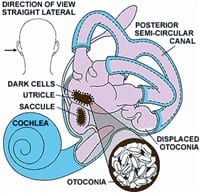A Road Map To The Future The Historic Human Genome Project Is Well Ahead Of Schedule
When scientists complete the Human Genome Project next year, two years ahead of schedule, it won’t mark an end of the initiative by any means — just a successful beginning.
Dr. Solveig Pflueger, director of Laboratory Genetics at Baystate Medical Center, relates the government-sponsored, 13-year effort to map the human genome to buying a book. All those years of work puts the book in researchers’ hands, and next they have to read it, she said. And that’s where the most complicated work — and, potentially, some of the greatest breakthroughs — will begin.
However, that’s not meant to downplay the Human Genome Project (HGP) itself, she said. Mapping the sequence of some 3 billion DNA base pairs on about 35,000 human genes is expected to serve as a historic scientific benchmark, especially if the information is eventually used to gain an understanding of — and prevent — now-incurable genetic diseases.
“We know there are many, many genes out there, and we can say there’s a gene that has this sequence located on this chromosome,” Pflueger said. “Do we know what that gene does, and do we know what effects mutations in that gene will have? Not necessarily. We may not know at this point what gene causes an inherited disease, and if we do, we may not know how changes are manifested. There’s a lot to do, and this is only the beginning.”
It’s an impressive beginning, to be sure. And by next year, scientists will finally be able to open the book and start reading every chapter.
Decades of Progress
In a roundabout way, the origins of the Human Genome Project date back to 1945, when the U.S. Department of Energy was charged by Congress to develop new energy resources and technologies. In 1986, the department launched its Human Genome Initiative, convinced that its mission would be well-served by a reference to the human genome sequence.
The department teamed with the National Institutes of Health (NIH) to develop a plan for a joint HGP. The project officially began in 1990 and was expected to last 15 years. In the coming years, the NIH eventually took over the project.
From the start, the main goal of the project has been to generate an accurate reference sequence for the entire human genome and to identify all human genes. The genome is an organism’s complete set of DNA — all 3 billion base pairs in the case of a human being — and, except for mature red blood cells, all human cells contain a complete genome.
The potential applications of mapping this information are numerous, including the creation of customized medicines, improving agricultural products, developing new energy resources, and creating tools for environmental cleanup.
Although the project was expected to conclude in 2005, rapid advances in technology and worldwide participation have accelerated the completion date. In June of 2000, biologists announced their most crucial achievement to date — the generation of a working draft sequence of the entire human genome. In addition to serving as a blueprint for the eventual finished version, the draft already provides a road map of sorts to some 90{06cf2b9696b159f874511d23dbc893eb1ac83014175ed30550cfff22781411e5} of genes on every chromosome and is already helping scientists pinpoint genes associated with more than 30 disorders. And that, too, is only the beginning, Pflueger said.
“With more knowledge of the human genome, we’ll be better able to diagnose diseases and find treatments for them,” she said. “However, it’s just in its infancy, and knowing the sequence of the human genome really doesn’t tell us how each of these genes works.
“Even if we know there’s a disease that’s clearly inherited, we might not know at this point what gene causes it, and if we do, we might not know how the particular changes are manifested,” she added. “So there’s really a lot to do.”
Lay people who associate the Human Genome Project solely with health and science applications might be surprised to hear of the wide range of applications expected to be made from this research. The uses cross the boundaries of medicine into food, energy, the environment, and commerce, fueling predictions in some circles that the life sciences stand on the brink of becoming a leading economic force in the United States in the 21st century.
In the field of genomics alone, dozens of companies have already sprung up, preparing to sell information, technologies, and services relating to the research into genes and their functions. According to the NIH, areas that could be affected by the research include:
• Clinical medicine, including the development of more individualized diagnostics and prognostics, drugs, and other therapies.
• Agriculture and livestock, which could see the emergence of hardier, more nutritious, and healthier crops and animals.
• Industrial processes, which could include more efficient manufacturing in such sectors as chemicals, pulp and paper, textiles, food, fuels, metals, and minerals.
• Environmental biotechnology, which expects the development of biodegradable products, new energy resources, environmental diagnostics, and less hazardous cleanup of mixed toxic-waste sites.
• DNA fingerprinting, evolutionary and human anthropological studies, and detection of and resistance to agents that could be used in biological warfare.
From the start, the agency asserts, HGP planners promoted the private sector’s participation in developing genomic resources and applications. The HGP’s successes, as a result, are giving rise to commercially viable products and services.
Answers and More Questions
Still, doctors and scientists are most excited about the medical potential of unlocking the secrets of genetics, particularly in the realm of tackling genetic
disorders.
“I think it’s going to be very significant because we’ll be able to identify individuals who are at risk of diseases that have a genetic basis and potentially intervene before they become symptomatic. So I see tremendous value in the area of preventive medicine,” Pflueger said.
“In the past, we really haven’t had anything that’s been that specific, but if you know someone’s going to have a specific problem with a particular genetic pathway, you can treat that and go a long way toward improving human life.“
This concept, she admits, does worry some ethicists who wonder whether that sort of genetic identification will lead to a day when technology allows parents to create ‘designer children,’ not only free from defects but born with pre-designed physical features.
“The public often worries about the possibility of genetically engineered children. Of course there’s always the potential for abuse, but I don’t really expect to see that,” Pflueger said.
At any rate, researchers have a long road ahead in even being able to identify gene functions that would make such a scenario possible. Still, scientists have identified about 1.4 million locations where single-base DNA differences occur in humans, and more than 30 specific genes have already been associated with breast cancer, muscle disease, deafness, and blindness. It’s only a matter of time, they say, before science unlocks ways to prevent a host of disorders.
“The main thing is that, in terms of genetic diseases, if you can identify an individual who is susceptible to heart disease or cancer — and we know diseases of this type have significant genetic bases — then we can either follow individuals at risk more closely or potentially find a therapy to prevent the disease from occurring in the first place,” Pflueger said. “And that’s where we want to be.”
Where scientists are right now is two years ahead of schedule — with the hope that they will soon write some of the most important chapters in medical history.



Comments are closed.